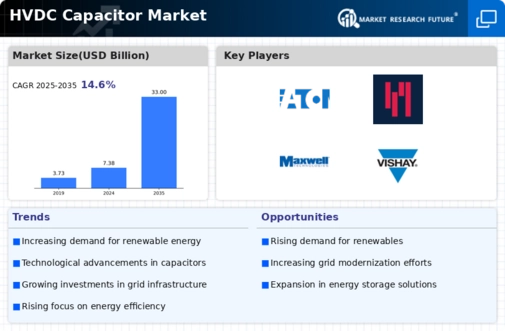-
EXECUTIVE SUMMARY
-
MARKET INTRODUCTION
-
2.1.
-
Definition
-
Scope of the Study
- Research Objective
- Limitations
-
2.2.2.
-
Assumptions
-
RESEARCH METHODOLOGY
-
Overview
-
Data Mining
-
Secondary Research
-
Primary Research
- Breakdown of Primary
-
3.4.1.
-
Primary Interviews and Information Gathering Process
-
Respondents
-
Forecasting Modality
-
Market Size Estimation
- Top-Down Approach
-
3.6.1.
-
Bottom-Up Approach
-
Data Triangulation
-
Validation
-
MARKET DYNAMICS
-
Overview
-
Drivers
-
Restraints
-
Opportunities
-
MARKET FACTOR ANALYSIS
-
5.1.
-
Value Chain Analysis
-
Porter’s Five Forces Analysis
- Bargaining
- Bargaining Power of Buyers
- Threat of
- Threat of Substitutes
- Intensity of Rivalry
-
Power of Suppliers
-
New Entrants
-
COVID-19 Impact Analysis
- Market Impact Analysis
- Regional
- Opportunity and Threat Analysis
-
Impact
-
GLOBAL HVDC CAPACITOR
-
MARKET, BY PRODUCT TYPE
-
Overview
-
Plastic Film Capacitors
-
Aluminum Electrolytic Capacitors
-
Ceramic Capacitors
-
Tantalum
-
Wet Capacitors
-
Others
-
GLOBAL HVDC CAPACITOR MARKET, BY TECHNOLOGY
-
Overview
-
Line-Commulated Converter (LCC)
-
Voltage-source
-
Converter (VSC)
-
GLOBAL HVDC CAPACITOR MARKET, BY INSTALLATION TYPE
-
8.1.
-
Overview
-
Open Rack Capacitor Banks
-
Enclosed Rack Capacitor Banks
-
Pole-mounted Capacitor Banks
-
GLOBAL HVDC CAPACITOR MARKET, BY APPLICATION
-
Overview
-
Commercial
-
Industrial
-
Aerospace and
-
Defense
-
Others
-
GLOBAL HVDC CAPACITOR MARKET, BY REGION
-
10.1.
-
Overview
-
North America
- U.S.
- Canada
- Germany
- France
- U.K
- Italy
- Spain
- Rest of Europe
-
10.3.
-
Europe
-
Asia-Pacific
- India
- Japan
- South Korea
- Rest of Asia-Pacific
-
10.4.1.
-
China
-
10.4.5.
-
Australia
-
Rest of the World
- Africa
- Latin America
-
10.5.1.
-
Middle East
-
COMPETITIVE
-
LANDSCAPE
-
Overview
-
Competitive Analysis
-
Market
-
Share Analysis
-
Major Growth Strategy in the Global HVDC Capacitor Market,
-
Competitive Benchmarking
-
Leading Players in Terms of Number of
-
Developments in the Global HVDC Capacitor Market,
-
Key developments and
- New Product Type Launch/Technology Installation Type
- Merger & Acquisitions
- Joint Ventures
-
Growth Strategies
-
Major
- Sales & Operating Income, 2022
-
Players Financial Matrix
-
11.8.2.
-
Major Players R&D Expenditure. 2022
-
COMPANY PROFILES
-
EATON
- Company Overview
- Financial Overview
- Product Types Offered
- Key Developments
- SWOT
- Key Strategies
-
CORPORATION PLC
-
Analysis
-
ABB Ltd
- Company Overview
- Financial Overview
- Product Types Offered
- Key
- SWOT Analysis
- Key Strategies
-
Developments
-
RTDS
- Company Overview
- Financial Overview
- Product Types Offered
- Key Developments
- SWOT
- Key Strategies
-
TECHNOLOGIES INC..
-
Analysis
-
Alstom SA
- Company Overview
- Financial Overview
- Product Types Offered
- Key
- SWOT Analysis
- Key Strategies
-
Developments
-
Maxwell
- Company Overview
- Financial Overview
- Product Types Offered
- Key Developments
- SWOT
- Key Strategies
-
Technologies Inc
-
Analysis
-
SIEMENS AG
- Company
- Financial Overview
- Product Types Offered
- SWOT Analysis
- Key Strategies
- Company Overview
- Financial Overview
- Product Types Offered
- Key Developments
- SWOT
- Key Strategies
-
Overview
-
12.6.4.
-
Key Developments
-
12.7.
-
Sieyuan Electric Co. Ltd
-
Analysis
-
Vishay Intertechnology Inc.
- Financial Overview
- Product Types Offered
- Key Developments
- SWOT Analysis
- Key Strategies
-
12.8.1.
-
Company Overview
-
TDK Corporation.
- Company Overview
- Financial Overview
- Product Types Offered
- Key Developments
- SWOT
- Key Strategies
-
Analysis
-
AVX Corporation (Kyocera Corporation).
- Company Overview
- Financial Overview
- Product
- Key Developments
- SWOT Analysis
-
Types Offered
-
12.10.6.
-
Key Strategies
-
APPENDIX
-
References
-
Related Reports
-
-
LIST OF TABLES
-
GLOBAL HVDC CAPACITOR MARKET, SYNOPSIS,
-
GLOBAL HVDC CAPACITOR MARKET, ESTIMATES & FORECAST, 2025-2034
-
(USD BILLION)
-
GLOBAL HVDC CAPACITOR MARKET, BY PRODUCT TYPE, 2025-2034
-
(USD BILLION)
-
GLOBAL HVDC CAPACITOR MARKET, BY TECHNOLOGY, 2025-2034
-
(USD BILLION)
-
GLOBAL HVDC CAPACITOR MARKET, BY INSTALLATION TYPE, 2025-2034
-
(USD BILLION)
-
GLOBAL HVDC CAPACITOR MARKET, BY APPLICATION, 2025-2034
-
(USD BILLION)
-
NORTH AMERICA HVDC CAPACITOR MARKET, BY PRODUCT TYPE,
-
NORTH AMERICA HVDC CAPACITOR MARKET, BY TECHNOLOGY,
-
NORTH AMERICA HVDC CAPACITOR MARKET, BY INSTALLATION
-
TYPE, 2025-2034 (USD BILLION)
-
NORTH AMERICA HVDC CAPACITOR MARKET,
-
BY APPLICATION, 2025-2034 (USD BILLION)
-
NORTH AMERICA HVDC CAPACITOR
-
MARKET, BY COUNTRY, 2025-2034 (USD BILLION)
-
U.S. HVDC CAPACITOR MARKET,
-
BY PRODUCT TYPE, 2025-2034 (USD BILLION)
-
U.S. HVDC CAPACITOR MARKET,
-
BY TECHNOLOGY, 2025-2034 (USD BILLION)
-
U.S. HVDC CAPACITOR MARKET,
-
BY INSTALLATION TYPE, 2025-2034 (USD BILLION)
-
U.S. HVDC CAPACITOR
-
MARKET, BY APPLICATION, 2025-2034 (USD BILLION)
-
CANADA HVDC CAPACITOR
-
MARKET, BY PRODUCT TYPE, 2025-2034 (USD BILLION)
-
CANADA HVDC CAPACITOR
-
MARKET, BY TECHNOLOGY, 2025-2034 (USD BILLION)
-
CANADA HVDC CAPACITOR
-
MARKET, BY INSTALLATION TYPE, 2025-2034 (USD BILLION)
-
CANADA HVDC
-
CAPACITOR MARKET, BY APPLICATION, 2025-2034 (USD BILLION)
-
EUROPE HVDC
-
CAPACITOR MARKET, BY PRODUCT TYPE, 2025-2034 (USD BILLION)
-
EUROPE
-
HVDC CAPACITOR MARKET, BY TECHNOLOGY, 2025-2034 (USD BILLION)
-
EUROPE
-
HVDC CAPACITOR MARKET, BY INSTALLATION TYPE, 2025-2034 (USD BILLION)
-
TABLE
-
EUROPE HVDC CAPACITOR MARKET, BY APPLICATION, 2025-2034 (USD BILLION)
-
TABLE
-
EUROPE HVDC CAPACITOR MARKET, BY COUNTRY, 2025-2034 (USD BILLION)
-
TABLE
-
GERMANY HVDC CAPACITOR MARKET, BY PRODUCT TYPE, 2025-2034 (USD BILLION)
-
TABLE
-
GERMANY HVDC CAPACITOR MARKET, BY TECHNOLOGY, 2025-2034 (USD BILLION)
-
TABLE
-
GERMANY HVDC CAPACITOR MARKET, BY INSTALLATION TYPE, 2025-2034 (USD BILLION)
-
GERMANY HVDC CAPACITOR MARKET, BY APPLICATION, 2025-2034 (USD BILLION)
-
FRANCE HVDC CAPACITOR MARKET, BY PRODUCT TYPE, 2025-2034 (USD BILLION)
-
FRANCE HVDC CAPACITOR MARKET, BY TECHNOLOGY, 2025-2034 (USD BILLION)
-
FRANCE HVDC CAPACITOR MARKET, BY INSTALLATION TYPE, 2025-2034 (USD BILLION)
-
FRANCE HVDC CAPACITOR MARKET, BY APPLICATION, 2025-2034 (USD BILLION)
-
ITALY HVDC CAPACITOR MARKET, BY PRODUCT TYPE, 2025-2034 (USD BILLION)
-
ITALY HVDC CAPACITOR MARKET, BY TECHNOLOGY, 2025-2034 (USD BILLION)
-
ITALY HVDC CAPACITOR MARKET, BY INSTALLATION TYPE, 2025-2034 (USD BILLION)
-
ITALY HVDC CAPACITOR MARKET, BY APPLICATION, 2025-2034 (USD BILLION)
-
SPAIN HVDC CAPACITOR MARKET, BY PRODUCT TYPE, 2025-2034 (USD BILLION)
-
SPAIN HVDC CAPACITOR MARKET, BY TECHNOLOGY, 2025-2034 (USD BILLION)
-
SPAIN HVDC CAPACITOR MARKET, BY INSTALLATION TYPE, 2025-2034 (USD BILLION)
-
SPAIN HVDC CAPACITOR MARKET, BY APPLICATION, 2025-2034 (USD BILLION)
-
U.K HVDC CAPACITOR MARKET, BY PRODUCT TYPE, 2025-2034 (USD BILLION)
-
U.K HVDC CAPACITOR MARKET, BY TECHNOLOGY, 2025-2034 (USD BILLION)
-
U.K HVDC CAPACITOR MARKET, BY INSTALLATION TYPE, 2025-2034 (USD BILLION)
-
U.K HVDC CAPACITOR MARKET, BY APPLICATION, 2025-2034 (USD BILLION)
-
REST OF EUROPE HVDC CAPACITOR MARKET, BY PRODUCT TYPE, 2025-2034 (USD
-
BILLION)
-
REST OF EUROPE HVDC CAPACITOR MARKET, BY TECHNOLOGY, 2025-2034
-
(USD BILLION)
-
REST OF EUROPE HVDC CAPACITOR MARKET, BY INSTALLATION
-
TYPE, 2025-2034 (USD BILLION)
-
REST OF EUROPE HVDC CAPACITOR MARKET,
-
BY APPLICATION, 2025-2034 (USD BILLION)
-
ASIA PACIFIC HVDC CAPACITOR
-
MARKET, BY PRODUCT TYPE, 2025-2034 (USD BILLION)
-
ASIA PACIFIC HVDC
-
CAPACITOR MARKET, BY TECHNOLOGY, 2025-2034 (USD BILLION)
-
ASIA PACIFIC
-
HVDC CAPACITOR MARKET, BY INSTALLATION TYPE, 2025-2034 (USD BILLION)
-
TABLE
-
ASIA PACIFIC HVDC CAPACITOR MARKET, BY APPLICATION, 2025-2034 (USD BILLION)
-
ASIA PACIFIC HVDC CAPACITOR MARKET, BY COUNTRY, 2025-2034 (USD BILLION)
-
JAPAN HVDC CAPACITOR MARKET, BY PRODUCT TYPE, 2025-2034 (USD BILLION)
-
JAPAN HVDC CAPACITOR MARKET, BY TECHNOLOGY, 2025-2034 (USD BILLION)
-
JAPAN HVDC CAPACITOR MARKET, BY INSTALLATION TYPE, 2025-2034 (USD BILLION)
-
JAPAN HVDC CAPACITOR MARKET, BY APPLICATION, 2025-2034 (USD BILLION)
-
CHINA HVDC CAPACITOR MARKET, BY PRODUCT TYPE, 2025-2034 (USD BILLION)
-
CHINA HVDC CAPACITOR MARKET, BY TECHNOLOGY, 2025-2034 (USD BILLION)
-
CHINA HVDC CAPACITOR MARKET, BY INSTALLATION TYPE, 2025-2034 (USD BILLION)
-
CHINA HVDC CAPACITOR MARKET, BY APPLICATION, 2025-2034 (USD BILLION)
-
INDIA HVDC CAPACITOR MARKET, BY PRODUCT TYPE, 2025-2034 (USD BILLION)
-
INDIA HVDC CAPACITOR MARKET, BY TECHNOLOGY, 2025-2034 (USD BILLION)
-
INDIA HVDC CAPACITOR MARKET, BY INSTALLATION TYPE, 2025-2034 (USD BILLION)
-
INDIA HVDC CAPACITOR MARKET, BY APPLICATION, 2025-2034 (USD BILLION)
-
AUSTRALIA HVDC CAPACITOR MARKET, BY PRODUCT TYPE, 2025-2034 (USD BILLION)
-
AUSTRALIA HVDC CAPACITOR MARKET, BY TECHNOLOGY, 2025-2034 (USD BILLION)
-
AUSTRALIA HVDC CAPACITOR MARKET, BY INSTALLATION TYPE, 2025-2034 (USD
-
BILLION)
-
AUSTRALIA HVDC CAPACITOR MARKET, BY APPLICATION, 2025-2034
-
(USD BILLION)
-
SOUTH KOREA HVDC CAPACITOR MARKET, BY PRODUCT TYPE,
-
SOUTH KOREA HVDC CAPACITOR MARKET, BY TECHNOLOGY,
-
SOUTH KOREA HVDC CAPACITOR MARKET, BY INSTALLATION
-
TYPE, 2025-2034 (USD BILLION)
-
SOUTH KOREA HVDC CAPACITOR MARKET, BY
-
APPLICATION, 2025-2034 (USD BILLION)
-
REST OF ASIA-PACIFIC HVDC CAPACITOR
-
MARKET, BY PRODUCT TYPE, 2025-2034 (USD BILLION)
-
REST OF ASIA-PACIFIC
-
HVDC CAPACITOR MARKET, BY TECHNOLOGY, 2025-2034 (USD BILLION)
-
REST
-
OF ASIA-PACIFIC HVDC CAPACITOR MARKET, BY INSTALLATION TYPE, 2025-2034 (USD BILLION)
-
REST OF ASIA-PACIFIC HVDC CAPACITOR MARKET, BY APPLICATION, 2025-2034
-
(USD BILLION)
-
REST OF WORLD HVDC CAPACITOR MARKET, BY PRODUCT TYPE,
-
REST OF WORLD HVDC CAPACITOR MARKET, BY TECHNOLOGY,
-
REST OF WORLD HVDC CAPACITOR MARKET, BY INSTALLATION
-
TYPE, 2025-2034 (USD BILLION)
-
REST OF WORLD HVDC CAPACITOR MARKET,
-
BY APPLICATION, 2025-2034 (USD BILLION)
-
REST OF WORLD HVDC CAPACITOR
-
MARKET, BY COUNTRY, 2025-2034 (USD BILLION)
-
MIDDLE EAST HVDC CAPACITOR
-
MARKET, BY PRODUCT TYPE, 2025-2034 (USD BILLION)
-
MIDDLE EAST HVDC
-
CAPACITOR MARKET, BY TECHNOLOGY, 2025-2034 (USD BILLION)
-
MIDDLE EAST
-
HVDC CAPACITOR MARKET, BY INSTALLATION TYPE, 2025-2034 (USD BILLION)
-
TABLE
-
MIDDLE EAST HVDC CAPACITOR MARKET, BY APPLICATION, 2025-2034 (USD BILLION)
-
AFRICA HVDC CAPACITOR MARKET, BY PRODUCT TYPE, 2025-2034 (USD BILLION)
-
AFRICA HVDC CAPACITOR MARKET, BY TECHNOLOGY, 2025-2034 (USD BILLION)
-
AFRICA HVDC CAPACITOR MARKET, BY INSTALLATION TYPE, 2025-2034 (USD BILLION)
-
AFRICA HVDC CAPACITOR MARKET, BY APPLICATION, 2025-2034 (USD BILLION)
-
LATIN AMERICA HVDC CAPACITOR MARKET, BY PRODUCT TYPE, 2025-2034 (USD
-
BILLION)
-
LATIN AMERICA HVDC CAPACITOR MARKET, BY TECHNOLOGY, 2025-2034
-
(USD BILLION)
-
LATIN AMERICA HVDC CAPACITOR MARKET, BY INSTALLATION
-
TYPE, 2025-2034 (USD BILLION)
-
LATIN AMERICA HVDC CAPACITOR MARKET,
-
BY APPLICATION, 2025-2034 (USD BILLION)
-
-
LIST OF FIGURES
-
FIGURE
-
RESEARCH PROCESS
-
MARKET STRUCTURE FOR THE GLOBAL HVDC CAPACITOR
-
MARKET
-
MARKET DYNAMICS FOR THE GLOBAL HVDC CAPACITOR MARKET
-
FIGURE
-
GLOBAL HVDC CAPACITOR MARKET, SHARE (%), BY PRODUCT TYPE, 2022
-
GLOBAL
-
HVDC CAPACITOR MARKET, SHARE (%), BY TECHNOLOGY, 2022
-
GLOBAL HVDC
-
CAPACITOR MARKET, SHARE (%), BY INSTALLATION TYPE, 2022
-
GLOBAL HVDC
-
CAPACITOR MARKET, SHARE (%), BY APPLICATION, 2022
-
GLOBAL HVDC CAPACITOR
-
MARKET, SHARE (%), BY REGION, 2022
-
NORTH AMERICA: HVDC CAPACITOR MARKET,
-
SHARE (%), BY REGION, 2022
-
EUROPE: HVDC CAPACITOR MARKET, SHARE (%),
-
BY REGION, 2022
-
ASIA-PACIFIC: HVDC CAPACITOR MARKET, SHARE (%), BY
-
REGION, 2022
-
REST OF THE WORLD: HVDC CAPACITOR MARKET, SHARE (%),
-
BY REGION, 2022
-
GLOBAL HVDC CAPACITOR MARKET: COMPANY SHARE ANALYSIS,
-
EATON CORPORATION PLC: FINANCIAL OVERVIEW SNAPSHOT
-
FIGURE
-
EATON CORPORATION PLC: SWOT ANALYSIS
-
ABB LTD: FINANCIAL OVERVIEW
-
SNAPSHOT
-
ABB LTD: SWOT ANALYSIS
-
RTDS TECHNOLOGIES
-
INC..: FINANCIAL OVERVIEW SNAPSHOT
-
RTDS TECHNOLOGIES INC..: SWOT
-
ANALYSIS
-
ALSTOM SA: FINANCIAL OVERVIEW SNAPSHOT
-
ALSTOM
-
SA: SWOT ANALYSIS
-
MAXWELL TECHNOLOGIES INC.: FINANCIAL OVERVIEW SNAPSHOT
-
MAXWELL TECHNOLOGIES INC.: SWOT ANALYSIS
-
SIEMENS AG:
-
FINANCIAL OVERVIEW SNAPSHOT
-
SIEMENS AG: SWOT ANALYSIS
-
FIGURE
-
SIEYUAN ELECTRIC CO. LTD: FINANCIAL OVERVIEW SNAPSHOT
-
SIEYUAN
-
ELECTRIC CO. LTD: SWOT ANALYSIS
-
VISHAY INTERTECHNOLOGY INC.: FINANCIAL
-
OVERVIEW SNAPSHOT
-
VISHAY INTERTECHNOLOGY INC.: SWOT ANALYSIS
-
FIGURE
-
TDK CORPORATION.: FINANCIAL OVERVIEW SNAPSHOT
-
TDK CORPORATION.:
-
SWOT ANALYSIS
-
AVX CORPORATION (KYOCERA CORPORATION): FINANCIAL OVERVIEW
-
SNAPSHOT
-
AVX CORPORATION (KYOCERA CORPORATION): SWOT ANALYSIS









Leave a Comment